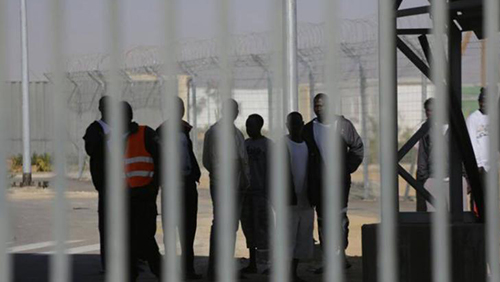What’s in a Name? Holot, an « Open Detention Facility » for « Infiltrators » in Israel

Political discourse and public debate are sites where exclusionary and criminalizing rhetoric about migrants emerges in visible and often explicit forms. A more “mundane” site of analysis is the everyday language of state bureaucracy: Administrative detention, “infiltrators”, and “open detention facility”. Officially, these terms are chosen based on technical or bureaucratic considerations. However, the way these choices are experienced, and their symbolic significance, cannot be ignored: They construct a punitive, criminal aura.
The Case Study
Approximately 38,000 asylum seekers from Sudan and Eritrea currently reside in Israel. All have entered Israel since 2005 through non-authorized border points, and most claim to have fled persecution in Sudan or human rights abuses in Eritrea. In 2013, Israel established Holot “open detention facility” in the middle of the Negev desert, approved by the Knesset (Israel’s Parliament). To date, approximately 10,000 people have been detained in Holot for a year-long detention. Detainees must be present for head counts in the mornings, evenings and sleep in the facility, while during the day, they are allowed outside the center’s confines. Israel’s Prison Authority runs the facility. Breach of disciplinary guidelines is punishable by sanctions, including removal to a closed facility, Saharonim, located across the road.
Photo: activestills.org
State employees or legal professionals frequently use three legal terms to describe Holot as a non-punitive arrangement. However, despite the claimed neutrality and administrative nature of these legal terms, a punitive effect takes place.
Administrative detention – which includes the arrest and detention of persons without an indictment, trial, or access to judicial review – has existed since 1948 when Israel was founded. The early days of Israeli statehood were characterized by the mass movement of hundreds of thousands of Palestinians who had been displaced during the 1947–1948 war. Those who crossed the border without the new State’s authorization were called “infiltrators”. Increased organized smuggling by militant groups called Fedayeen in the early years of the state, led to the legislation of the Prevention of Infiltration Law in 1954. Since 2012, this law has been expanded, contested in court, and amended; with the goal to regulate asylum seekers who entered the country through non-authorized border points, and to enable their detention.
State employees and legislators insist that administrative detention is not punitive, and therefore does not need to comply with individual criminal law procedures and protections. However, similarities between administrative detention and penal incarceration came under scrutiny in Israel’s Supreme Court and in legislative committees. As explained in the third verdict on detention in Holot by Justice Vogelman: “Long periods of detention cross the border between a ‘disciplinary’ sanction, which is largely carried out for the sake of deterrence, and a ‘penal’ sanction, which is punitive in its essence” (author’s translation). Scholars, activists and lawyers questioning the legislative aim of detention, its covert and overt goals picked up this observation.
The blurred or intersecting border between criminal law and immigration law has been vastly explored by Juliet Stumpf and others under the term crimmigration. Two criteria ascertain when processes of crimmigration law may become punitive: when those subjected to the process experience it as punitive, and when the process is enacted as a sanction by the state.
Accounts of lived experiences in detention as punishment are unfortunately plentiful. Detention’s punitiveness becomes even more palpable when criminal justice means are employed toward its implementation. Penal system staff, institutions, legal frameworks and moral weight of censure and sanction, endow such processes with punitive meaning.
Nonetheless, state officials insist that administrative detention is a distinctly different legal category than penal incarceration, and not a punitive sanction. In this insistence, state and legal professionals run the risk of what Lucia Zedner terms “penal subversion”. A process of re-labeling measures as non-punitive which is in effect “a cynical subversion of the criminal process and its human rights protections”.
Infiltrator is the legal category afforded to those who entered Israel through non-authorized border points. According to Israel’s Ministry of Interior, as of July 2017 38,540 “infiltrators” reside in Israel. More than a quarter of this population has been detained, and a larger number submitted asylum claims. As removal to Sudan and Eritrea may prove a risk to life or safety of these persons, they cannot be deported, under the international legal principle of non-refoulement. Upon completion of one year in detention they are released with a conditional visa.
Although Israel is signatory of the 1951 UN Convention on the Status of Refugees and its 1967 Protocol, which foresees the legal status of “asylum seeker” for persons seeking refuge, it chose to use the term “infiltrator” and regulates African migrants under the Prevention of Infiltration Law. This choice of legal framework, makes African migrants infiltrators rather than asylum seekers or refugees. State officials insist that there is no negative connotation attached to the term. The legal category simply refers to the unlawful way in which migrants crossed the border. Contrarily, academic literature has contextualized this discursive strategy as part of global trends of securitizing migration and pointed to specific attributes unique to the Israeli case study; most importantly, the association of the term “infiltrator” with the Israeli Palestinian conflict.
Open detention facility is the official description of Holot. Holot is run by Israel’s Prison Authority, it looks like Saharonim prison, and is closed off to the general public. It is compulsory for detainees to remain in the center and comply with its rules, under staff supervision. Breach of regulations is punished by disciplinary sanctions or move to closed detention. Holot’s location – in the middle of the desert – also raises doubts as to its openness. Social exclusion is still maintained by its vast physical distance from the public. Whereas state officials may call Holot an “open detention facility”, its various attributes cited above signal a punitive state approach to a group meriting exclusion, resembling state treatment of deviance and crime.
The everyday use of legal, bureaucratic language enables a disregard of symbolic significance, and denial of the punitive essence of detention, through technical language and professional distancing. Criminalization of asylum seekers is thus not only facilitated through dramatic statements, made by politicians on the public stage; but also in the daily work of bureaucratic agents as they translate these sentiments into state law, and discursive constructions into material existence.
Maayan Ravid
DPhil candidate, Centre for Criminology, University of Oxford
This is a shortened version of a post of Border Criminologies’ themed series on “Exploring the Everyday of Immigration Detention” organized by Annika Lindberg, University of Bern, and Laura Rezzonico, University of Neuchatel and nccr – on the move. It was originally published on 28 November 2017. The series brings together insights on the everyday of immigration detention, which has become a normalized part of the deportation regime and is one of many instruments used by states to discipline, control and deport “undesirable” migrants from their territory.



